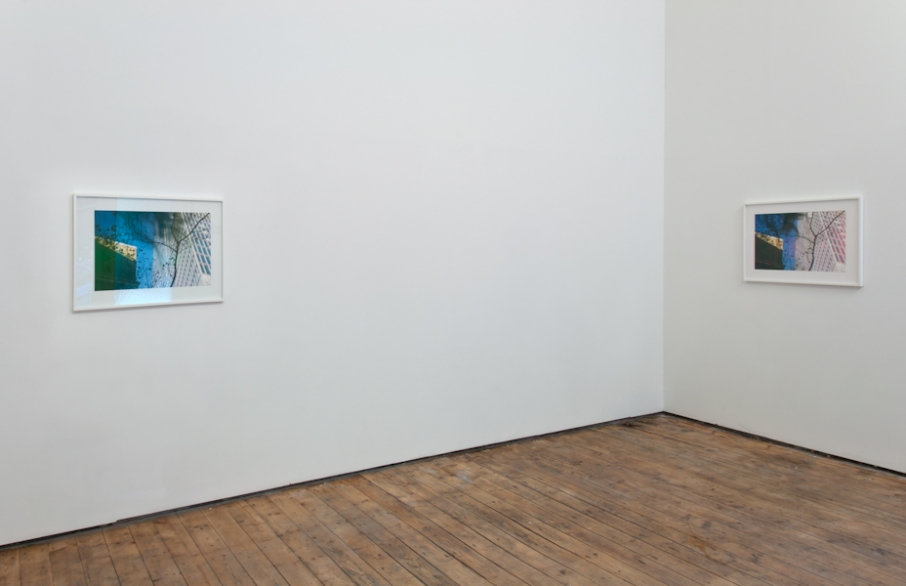Luster
Luster is a series of three archival pigment prints on paper. In the exhibition of the same title at Schneiderei, Vienna the works were presented with the sound installation A Slow Loop (9’35”, looped, 2013) and a digital reproduction of the original 16mm film The Knife (4’00” looped, 1974) by Jack Goldstein.
The starting point for this body of work is the optical phenomenon of binocular luster. Binocular luster occurs when an individual’s two eyes are independently stimulated by something alike in structure, yet different in colour or illumination. The brain is neither able to stabilise and fuse these images into a regular binocular view, nor suppress one eye’s stimulus in favour of the other. One experiences a pulsing flicker of receding and advancing colour; a slow loop beginning with one eye, then a fusion of the two, followed by the second as it becomes dominant.
The three photographs in Luster indivdually titled: “Luster (Green) Dusk. Grey” “Luster (Red) Bright. The blinds have been lowered.” and “Luster (Red) Dark. Dark. Except for gleams of light.” are a sequence of shots taken in rapid succession using a digital camera. Each image captures, at an obtuse angle, the same view from the base of The Shard skyscraper in London. This site is framed through a myriad of ‘real’ and digitally produced layers and filters: quivering tree branches; hair whisping in the wind; lens flares of red or green; and fringes of mis-aligned RGB colour layers. This treatment of the image extends to it’s display, with the white borders subtely tinted in red or green, and the images set slightly off-center.
Throughout the exhibition space A Slow Loop is audible. The voice of a female radio narrator, recounts in the first person a conversation between three characters: the left eye; the right eye; and the brain. The dialogue is steeped in repetition as momentary interactions are revisited from each characters perspective, to be embellished with inward thoughts that could at times signify longing or the awareness of being watched by the other.
A further element in the exhibition is a 4:3 TV monitor, screening on loop The Knife (1974) by Jack Goldstein. For the duration of four minutes, laying on a flat blue background, a static silver table knife is filmed with a sequence of coloured lights slowly moving across it –from blue, to red, to green; Each light flooding the knife with colour, before returning it to its original state. The Knife brings an additional sense of scale and depth to Luster which makes direct connections to the body and hands. In addition it represents an important historical moment within post conceptual art, when immaterial ‘affect’ was recognised for it’s political agency. “...I want to turn a thought into something tangible–an object–and then back into a thought.[1]”
Each element in Luster offers the viewer a ‘non-narrative’ which neither unravels to reveal a full plot, nor settles into the background as an abstraction. The exhibition is a palimpsest of sequenced and looping time. In this way the subjects of time, memory and history become equated with vision and one’s inablities to see depth in space.
Luster has developed from an investigation which originated in the HD video ‘grey sky blue’ and explores forms of indistincton, blurriness, and ambiguity found in the various platforms we inhabit and communicate through: from architecture to the computer screen. The works question how to represent such indistinguishable and often vague attributes.
In parallel, modes of perceptual or cognitive alterity such as strabismus or lazy eye, have been key resources, using them in the work as potential filters to percieve and understand these affective qualities.
--------------------------------
[1] Jack Goldstein “Talking to Jack Goldstein,” interview by Morgan Fisher, Los Angeles Institute of Contemporary Art Journal no. 14, April/May 1977.

Schneiderei, Vienna (2013)

2013, framed iris print, 790mm x 538mm
Set of 3 framed archival pigment prints on paper.
546mm × 798 mm

2013, framed iris print, 790mm x 538mm
Set of 3 framed archival pigment prints on paper
546mm × 798 mm

Installation view 'Luster' Schneiderei, Vienna (2013)

Installation view 'Luster' Schneiderei, Vienna (2013)

Installation view 'Luster' Schneiderei, Vienna (2013)

A digital reproduction of Goldstein’s original 16mm film
Looped, 4 min
(1974)